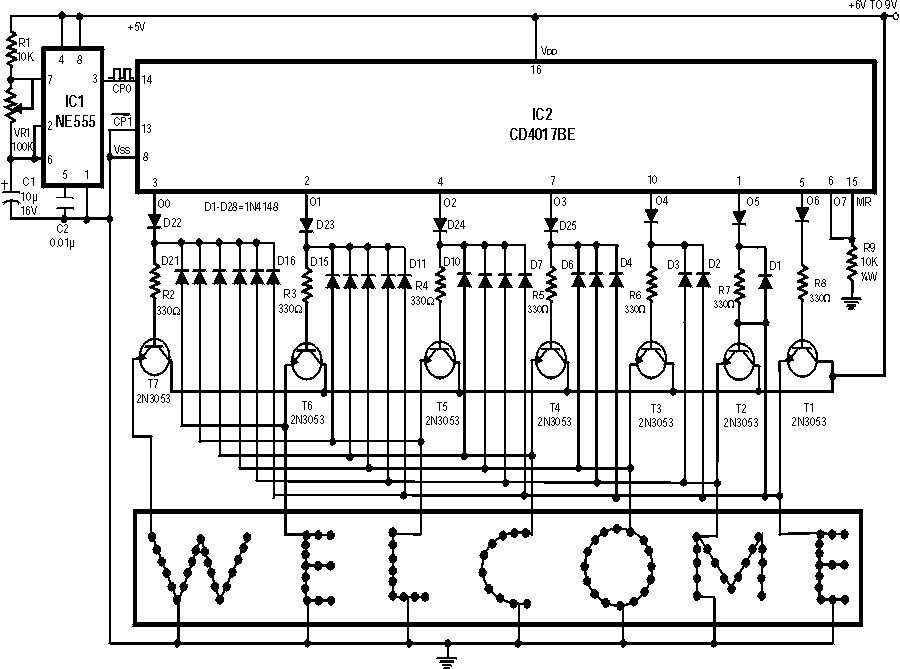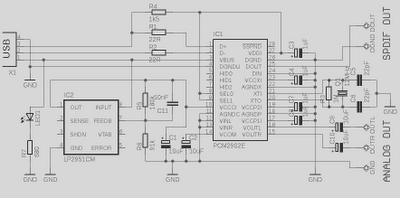
Running Message DisplayCircuit Based On The CD401IC

Running Message Display Circuit Diagram. This circuit is based on the CD401 IC. Features: Light emitting diodes are advantageous due to their smaller size.
The Running Message Display Circuit utilizes the CD401 integrated circuit, which is a versatile component in digital electronics. This circuit is designed to control a series of light-emitting diodes (LEDs) to create a scrolling text effect, making it suitable for various display applications such as advertising, information boards, or decorative signage.
The circuit typically consists of a microcontroller or a timer circuit that interfaces with the CD401 IC. The CD401 is a binary counter that can drive multiple outputs, making it ideal for controlling a sequence of LEDs. The LEDs are arranged in a matrix or a linear configuration, depending on the design requirements.
In a standard implementation, the microcontroller sends data to the CD401, which then activates the LEDs in a specific sequence to create the desired message. Resistors are used in series with the LEDs to limit current and prevent damage. Additionally, a power supply circuit is included to ensure that the entire system operates within the required voltage and current specifications.
The advantages of using LEDs in this circuit include their low power consumption, long lifespan, and compact size, which allows for more flexibility in design and installation. The use of the CD401 IC simplifies the circuit design by reducing the number of discrete components needed, thereby enhancing reliability and ease of assembly.
Overall, the Running Message Display Circuit is an effective solution for creating dynamic visual displays using LED technology, driven by the capabilities of the CD401 integrated circuit.Running Message Display Circuit Diagram. This circuit Based On The CD401IC. Fetures: Light emitting diodes are advantageous, cos smaller size, .. 🔗 External reference
The Running Message Display Circuit utilizes the CD401 integrated circuit, which is a versatile component in digital electronics. This circuit is designed to control a series of light-emitting diodes (LEDs) to create a scrolling text effect, making it suitable for various display applications such as advertising, information boards, or decorative signage.
The circuit typically consists of a microcontroller or a timer circuit that interfaces with the CD401 IC. The CD401 is a binary counter that can drive multiple outputs, making it ideal for controlling a sequence of LEDs. The LEDs are arranged in a matrix or a linear configuration, depending on the design requirements.
In a standard implementation, the microcontroller sends data to the CD401, which then activates the LEDs in a specific sequence to create the desired message. Resistors are used in series with the LEDs to limit current and prevent damage. Additionally, a power supply circuit is included to ensure that the entire system operates within the required voltage and current specifications.
The advantages of using LEDs in this circuit include their low power consumption, long lifespan, and compact size, which allows for more flexibility in design and installation. The use of the CD401 IC simplifies the circuit design by reducing the number of discrete components needed, thereby enhancing reliability and ease of assembly.
Overall, the Running Message Display Circuit is an effective solution for creating dynamic visual displays using LED technology, driven by the capabilities of the CD401 integrated circuit.Running Message Display Circuit Diagram. This circuit Based On The CD401IC. Fetures: Light emitting diodes are advantageous, cos smaller size, .. 🔗 External reference




